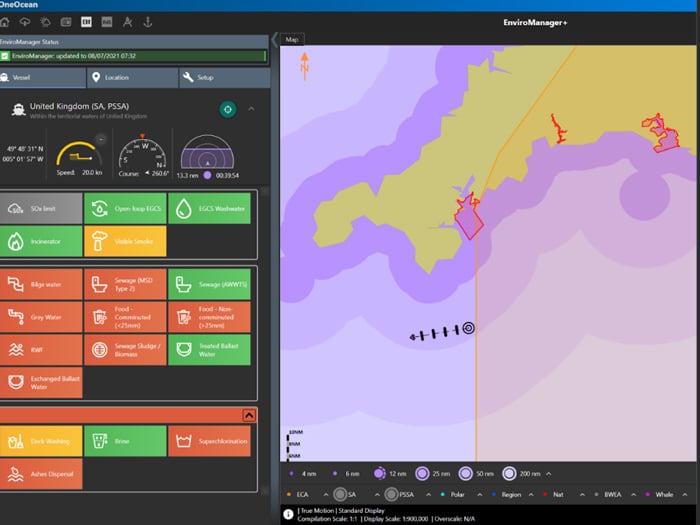
Q&A: 10 minutes with OneOcean on its path to sustainability
Written by Heather Ervin
Many regulations related to waste management and disposal only come into force when a vessel is within one of these zones, which makes the challenge of determining the precise boundaries of zones all the more crucial. (Credit: OneOcean)
OneOcean is a global supplier of voyage solutions for the maritime industry, used by over 15,000 vessels across the world. OneOcean’s solutions are focused on supporting and optimizing navigation and compliance while also offering more efficient, cleaner, and safer practices.
Marine Log spoke with Adam Pang and Nicholas Bourque about OneOcean, their maritime solutions, and the path to a more sustainable maritime industry.
Pang joined OneOcean in February 2021 as chief commercial officer, and is responsible for defining and maintaining commercial strategy, architecting and integrating the revenue system, and designing and launching revenue generating programs to drive business growth and market share. As CCO, Adam will take ownership of the customer and the customer interface making sure that all functions of the organization are aligned to meet its strategic commercial objectives.
He has over 20 years’ experience in B2B software environments, building commercial teams at scale using modern data driven insights and the latest technology to empower global teams.
Bourque is chief strategy officer at OneOcean, and his role is to bring OneOcean’s product portfolio together to create connected solutions that deliver real benefits for the maritime industry. Nicholas also focuses on developing the company’s future strategy and delivering its vision to offer solutions that reinforce safer, cleaner, and more efficient working practices.

Marine Log (ML): Can you begin by describing what sustainability means to OneOcean, both broadly and in the context of the maritime industry?
Nicholas Bourque (NB): For OneOcean, sustainability means helping our customers meet the needs of their business in the present without compromising the ability of future generations to meet their needs. It means promoting a business model that ties growth and progress to the promotion of a healthy environment.
In our sector of the industry, which is maritime technology, this entails empowering our customers, ship owners and managers, to adjust their fleet operations to promote higher standards of environmental excellence. Within the context of our portfolio, this means helping customers plan and implement efficient, compliant, high quality seafaring practices that lower emissions, minimize waste, and eliminate environmental regulatory infractions that compromise marine ecosystems and lead to heavy fines.
ML: What is the relationship between efficiency and sustainability, and how does technology, such as that offered through OneOcean, facilitate both?
NB: High levels of efficiency are a requirement to achieving sustainability. If lack of sustainability can be thought of as prioritizing the needs of the present with no regard to how they are detrimental to the needs of the future, then it stands to reason that these practices don’t make an efficient use of resources over the long term.
The OneOcean suite of products facilitates a holistic approach to understanding and improving environmental performance for ship owners and managers. Our portfolio enables shoreside teams and onboard crew to communicate effectively, and work in unison to manage and ensure environmental compliance and reduce risk.
The introduction of remote technology also allows services and data to be delivered digitally. This has a far lower carbon footprint than the deployment of paper and hardware-based data. Digital technology such as ours provides quicker updates on evolving situations. During voyages, leaders need to be able to draw on real-time data to empower better-informed and therefore more environmentally friendly decision-making in potentially turbulent situations.

ML: Can you talk a little bit about OneOcean’s Environmental Planner, and how it offers shipping companies with a more sustainable approach to operating business?
Adam Pang (AP): The Environmental Planner in OneOcean’s EnviroManager+ uses a dynamic, colour-coded timeline to provide a real-time look ahead at each of the environmental rules and restrictions in force during a voyage. The timeline displays a comprehensive list of environmental events broken down by waste stream, and visually depicts when they can safely and legally take place aboard a vessel during a rolling 12-hour window, based on the ship’s departure time, its current position, and speed.
This makes it much easier to plan operations around regulations in place, with peace of mind that vessels are in full compliance with environmental restrictions. Relevant data for environmental planning and navigation is presented on one screen, meaning data sets can be visualised in context to each other. Actions, such as discharges and emissions, are detailed by category and can be grouped in line with the user’s specifications.
Companies can also use this functionality to enforce their environmental policies that go above and beyond the minimum requirements. For example, companies can decide if they want to implement their own location-based restriction for ballast water exchange. An example would be a company deciding on its restricted zone for mid-ocean ballast water exchange prior to entering the Great Lakes, which could be within 250 nautical miles of shore rather than the externally mandated 200 nautical miles limit.
The environmental timeline also allows users to see where various environmental zones are and how long the ship is likely to remain in the zone where vessels must comply with regulations or stringent company guidelines. Color codes indicate whether the status of a given operational event is green: legal, amber: legal with conditions, or red: illegal. If there are deviations from the passage plan, such as a delay in departure time, the timeline will automatically update to accurately reflect real-time conditions, thus ensuring any discharges and emissions take place compliantly along the route.
This high visibility allows for much better voyage planning and monitoring and significantly reduces the risk of non-compliance with environmental regulations.
ML: Why does OneOcean feel it is important for the maritime industry at large to prioritize sustainability, and what steps do you hope the industry takes to move in that direction?
NB: The sheer volume of maritime travel currently taking place around the world means that the industry has an enormous environmental impact. We know that pollution from vessels in the skies and sea is harmful to the planet on both a macro and micro level. Fortunately, new technologies and practices are emerging that can reduce environmental harm from vessels and make the industry more sustainable overall. Implementing these new technologies will necessitate a desire by all stakeholders to hold vessels and maritime shoreside facilities to a higher standard of environmental performance by incentivizing energy efficient and sustainable practices.
It is our hope that as new technologies emerge, ship owners and managers will be compelled by maritime authorities at all levels to make use of them to improve their environmental performance. We are pleased by the CII and EEDI requirements from the IMO coming into effect in 2024 and it is our hope that all industry stakeholders will take a proactive approach to complying with the new standards by seeking to achieve more than the bare minimum compliance requirements. It is also our hope that these new regulations will spur more technological advancements that could revolutionize the industry and radically reduce pollution and waste produced by vessels.
ML: Can you talk about the challenges of waste management and disposal regulations in the maritime industry, and how OneOcean addresses those challenges?
AP: One of the most common challenges faced by our industry is accurately determining land baselines, from which all maritime zones, including territorial seas, contiguous zones and exclusive economic zones are measured. Many regulations related to waste management and disposal only come into force when a vessel is within one of these zones, which makes the challenge of determining the precise boundaries of zones all the more crucial. Compounding the confusion, depending on unique topographical features, baselines are not always calculated the same way and can occasionally change. OneOcean’s EnviroManager contains the only consolidated source of all land baselines, allowing users to accurately determine boundaries and visualize where regulations are in effect.
In the voyage planning process, our customers also face the challenge of consolidating multiple disparate sources of information to plan routes that take all navigational, commercial, safety, compliance, and environmental factors into account. When requirements are evaluated separately, from siloed sources, and pieced together manually, it can be difficult to access the big picture view needed to plan for efficient, sustainable onboard practices.
As far as waste management and disposal regulations are concerned, the best way to ensure these actions are performed in a compliant manner is through considerable planning before the journey begins. High quality planning relies on a big picture view of multiple voyage elements, where data is dynamically linked, and interdependent factors can be evaluated together at once. Voyage planning should take operational details regarding discharges into account, and tie waste stream management to other relevant variables such as weather, routing, and a detailed understanding of when and where events can and should take place along a route.
Lack of planning often results in erroneous infractions, which, in turn, result in fines and other penalties. When operational events related to waste disposal are planned with appropriate regard for both regulations and operational efficiency, the risk of faulty discharges is much reduced.
ML: Relatedly, can you talk about OneOcean’s partnership with Green Marine, the environmental certification program for the North American marine industry? What do you think is the importance of maritime companies self assessing their sustainability progress?
NB: OneOcean recently joined Green Marine as a partner because we are committed to driving sustainable practices and making our industry a greener one. Our software portfolio of environmental solutions affirms this commitment and makes us well-suited to this role. We provide greater awareness to our customers and give them a practical means of embedding and deploying higher environmental standards in their fleet operations.
We were impressed by Green Marine’s environmental certification program, which unites stakeholders from across the industry, encouraging ship owners, port authorities, terminals, seaway corporations and shipyards to go above and beyond external regulations and reduce their environmental footprint and document their progress through an annual self-assessment.
We believe that in order for there to be meaningful change in environmental practices in the maritime industry, companies will have to first and foremost strive to improve their own internal standards for how they operate. They must begin by understanding how they are performing to determine where to focus effort to continuously improve. Green Marine’s assessment is a great way to benchmark progress and bring attention to areas of improvement.
While much change will be externally mandated by the IMO, nations, flag states and port authorities in the coming years, companies will be better equipped to improve their environmental performance in a way that saves money and improves efficiency if they self-evaluate and determine their own opportunities for improvement and implement these proactively. Doing this methodically will allow them to determine when and where investments can be made, plan operational changes and train crews in a timely manner.
ML: What would your advice be to companies in the maritime industry looking to begin engaging with more sustainable practices?
AP: To firstly understand their current performance; how sustainable are your current practices? It is challenging to respond to the needs of the volatile maritime market while also ensuring high levels of safety, compliance, and environmental responsibility. We believe in employing a systematic approach that relies on high quality, integrated data to inform better planning and real-time decision making.
This includes access to logged data, detailed, vessel-specific information on previous voyages, including commercial requirements, passage plans, fuel costs, discharges, and emissions trends, to name just a few. Once these data sets are evaluated individually and in context to each other, companies can identify gaps, determine a strategy, and plan for improvement.
We also believe in the importance of shared access to information by ship and shoreside teams, which enables higher quality communication, improved efficacy, and reduced confusion.
Finally, we understand how critical it is for shoreside teams to have mechanisms in place to embed company environmental standards into onboard operations to ensure day to day actions align with company goals. Our solutions provide the means to make this a reality.




